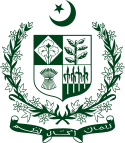
Back পাকিস্তানের সাধারণ নির্বাচন, ২০০২ Bengali/Bangla Parlamentswahlen in Pakistan 2002 German Élections législatives pakistanaises de 2002 French Pemilihan umum Pakistan 2002 ID پاکستان دے عام انتخابات، 2002ء PNB Парламентские выборы в Пакистане (2002) Russian پاڪستاني عام چونڊون، 2002 Sindhi پاکستان کے عام انتخابات، 2002ء Urdu 第8屆巴基斯坦下議院選舉 ZH-YUE
| |||||||||||||||||||||||||||||||||||||||||||||||||||||
All 342 seats in the National Assembly 172 seats needed for a majority | |||||||||||||||||||||||||||||||||||||||||||||||||||||
|---|---|---|---|---|---|---|---|---|---|---|---|---|---|---|---|---|---|---|---|---|---|---|---|---|---|---|---|---|---|---|---|---|---|---|---|---|---|---|---|---|---|---|---|---|---|---|---|---|---|---|---|---|---|
| Turnout | 41.76% ( | ||||||||||||||||||||||||||||||||||||||||||||||||||||
| |||||||||||||||||||||||||||||||||||||||||||||||||||||
 Results of elections showing political parties. | |||||||||||||||||||||||||||||||||||||||||||||||||||||
| |||||||||||||||||||||||||||||||||||||||||||||||||||||
 |
|---|
|
|
General elections were held in Pakistan on 10 October 2002 to elect the 12th National Assembly and four Provincial Assemblies. The elections were held under the military government of Pervez Musharraf.[1] The two mainstream parties, Pakistan Peoples Party (PPP) and Pakistan Muslim League (N) (PML-N) had several restrictions imposed on them and their leaders Benazir Bhutto and Nawaz Sharif were in exile. In order to address the restrictions, PPP created the Pakistan Peoples Party Parliamentarians (PPPP) under the leadership of Ameen Faheem, to contest the elections on its behalf. The PML-N meanwhile, suffering from the party's division into two factions: one that remained loyal to Sharif and were contesting the elections under the leadership of Javed Hashmi, and the other which had broken away to form the pro-Musharraf Pakistan Muslim League (Q) (PML-Q) under the leadership of Mian Muhammad Azhar. The emergence of the PML-Q marked the beginning of multi-party politics in the country, bringing an end to the decade-long two-party system between the PPP and PML-N.
The newly formed PML-Q - referred to as King's party due to President Musharraf's support - won the highest number of seats in the National Assembly. Despite the absence of Benazir Bhutto, PPPP came at a close second, and actually dominated in terms of popular vote. In opposition to the liberal regime of Musharraf, Islamist parties had organised themselves into the right-wing alliance Muttahida Majlis-e-Amal (MMA) prior to elections. The MMA ended up becoming the third largest party in National Assembly. PML-N suffering from Nawaz Sharif's absence and party split, finished fourth. At the provincial level, PPPP emerged as the largest party in Sindh, PML-Q was triumphant in Punjab, whereas MMA won the most seats in NWFP and Balochistan. With help of other pro-Musharraf parties such as MQM and National Alliance, PML-Q formed a government not only in the Centre but also in all provinces besides NWFP. Since Mian Muhammad Azhar had failed to win a seat himself, PML-Q and its allies agreed on the appointment of Zafarullah Jamali as the next Prime Minister
© MMXXIII Rich X Search. We shall prevail. All rights reserved. Rich X Search





